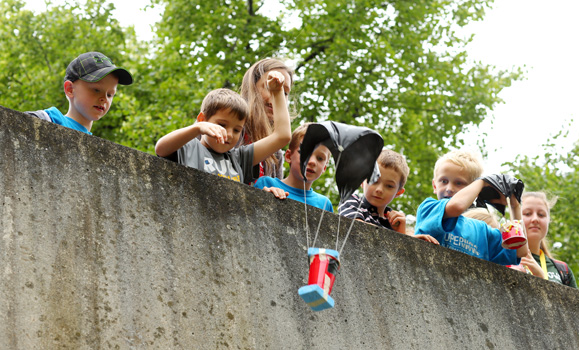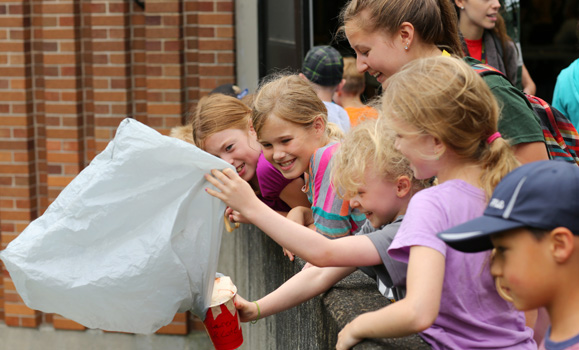Dixie cups, popsicle sticks and ÔÇťgoogly" eyes: not exactly the first tools that leap to mind when you think about science, technology, engineering and math (often known as the ÔÇťSTEMÔÇŁ topics).
But theyÔÇÖre the fun tools of the trade on one particular Thursday for 20 children from Demetreous Lane, a public housing development in Dartmouth, participating in an outreach camp with .
The Dixie cups are legs for a raised maze. ÔÇťI did it,ÔÇŁ calls out Morgan, five, when she succeeds at taping the fourth ÔÇťlegÔÇŁ to the maze she drew herself.
The googly eyes decorate a ÔÇťmagnetic creatureÔÇŁ ÔÇö its body made of Styrofoam glued onto a magnet ÔÇö that Morgan will guide through the maze with another magnet glued onto a stick.
Liz Everett, going into her fifth year of Marine Biology studies at Dal, is one of the SuperNOVA staff guiding the rambunctious group through the activity.
ÔÇťI can think back and think of a lot of teachers that made me care,ÔÇŁ says Everett, who became a counselor-in-training at 14 and has worked officially with SuperNOVA for two years. ÔÇťEven if I can get one or two kids more interested then itÔÇÖs a really cool opportunity to have an impact on a kid.ÔÇŁ
Targeting key communities
For 18 years, SuperNOVA has been getting kids excited about STEM subjects through an ongoing series of camps and workshops. While SuperNOVA is best known for its summer camp program, its outreach camps throughout the year are where the organization does some of its most important work, targeting youth from communities underrepresented in STEM studies at the moment. The camp at┬áDemetreous Lane, for example, was targeted at African Nova Scotian youth. This outreach aspect of SuperNOVAÔÇÖs work is supported by Actua, a national registered charity that connects 35 similar programs across Canada.
ÔÇťWe basically look at who are the scientists of the day and who isnÔÇÖt being represented or who doesnÔÇÖt have the opportunity to engage with science, technology engineering and mathematics otherwise,ÔÇŁ says Sagar Jha, currently SuperNOVAÔÇÖs co-director.
Jha, a recent Marine Biology graduate, is best known to the Dal community as last year's H┬■╗ş Student Union president. Starting in September, heÔÇÖll take the reins as SuperNOVAÔÇÖs sole director, helping the organization advance its important mission.
ÔÇťItÔÇÖs not like, ÔÇśLetÔÇÖs parachute into this community, do a science camp, and parachute out.ÔÇÖ WeÔÇÖre more focused on that deeper longer-term relationship,ÔÇŁ says Jha of SuperNOVAÔÇÖs outreach work across Nova Scotia, Prince Edward Island and Newfoundland. Partner organizations ÔÇö in the case of the Dartmouth camp, the Demetreous Lane Community Centre and First Baptist Church ÔÇö provide the logistics and the youth, and SuperNOVA comes in and delivers the program.
This summer, for example, two teams of SuperNOVA staff are in Labrador to run camps in seven communities, both on the coast and inland.
ÔÇťOur goal is to have all youth realize that a career in [STEM] is possible if they want it,ÔÇŁ says Jha.

New programs, new outreach
Before summer camp season kicked off, SuperNOVA also did workshops in elementary and junior high classes across Nova Scotia and Prince Edward Island, reaching some 3,500 students.
ÔÇťWe also do girls-only outreach for those male dominated fields,ÔÇŁ notes Jha, who followed his three older sisters, and their father before them, to study at Dal.
"I.T.S. (Industry, Technology and Science) for Girls" is both a series of summer camps and a club program that operates throughout the school year with support from the Canadian WomenÔÇÖs Foundation.
ÔÇťThatÔÇÖs one of the programs that as a director IÔÇÖm really excited about,ÔÇŁ says Jha, ÔÇťto know that SuperNOVA can provide an empowering experience for a group of girls and young women with very positive and strong role models who are already in those fields.ÔÇŁ
As a Marine Biology alum, Jha ÔÇö whose first-name, Sagar, means ÔÇťocean,ÔÇŁ fittingly enough ÔÇö is also excited to see the oceans component of SuperNOVA grow, with a $100,000, three-year grant from NSERC.
ÔÇťWeÔÇÖre connecting engineering back to oceans. WeÔÇÖre connecting computer science back to oceans,ÔÇŁ says Jha, of the camps happening this summer. In addition to rolling out a new ocean themed classroom workshop in the spring, SuperNOVA will also offer its first weeklong camp focused solely on ocean science and technology in late August.
ÔÇťWith the opening of the new [Steele] Ocean Sciences Building, and being on the coast, and H┬■╗ş really establishing itself as the ocean research institute of the nation, I think SuperNOVA gets to play a fun role ÔÇŽ in terms of sending that message to the Halifax community,ÔÇŁ Jha continues. ÔÇťThe kids from the community are coming into the university and seeing some of the cool ocean activities and research thatÔÇÖs going on here.ÔÇŁ

Discovering science and technology
Jha notes that SuperNOVA is 18-years-old in 2014: ÔÇťReady to go to university, which is kind of cool to think about.ÔÇŁ He hopes to see its success grow by having former participants become staff members.
Back in Dartmouth, some older children reflect on what theyÔÇÖve learned at SuperNOVA so far. The clear standout activity: building a landing pad and testing its properties by dropping an egg on it from the top of a ladder.
ÔÇťWe all got the same materials to do itÔÇŽ duct tape, masking tape, garbage bags ÔÇö for a parachute ÔÇö and a Styrofoam cup,ÔÇŁ rhymes off Xavier Buckley, 10. ÔÇťMy egg survived.ÔÇŁ
Buckley says the camp has got him interested in structures. Joel McCombie, 11, echoes that. ÔÇťWe had to build structures out of certain materials ÔÇö like popsicle sticks, straws, tape and stuff like that,ÔÇŁ says Joel. ÔÇťYou had to make it stay together through a whole bunch of stuff ÔÇö like fans, water.ÔÇŁ
A smile lights his face.
Learn more about SuperNOVA .

